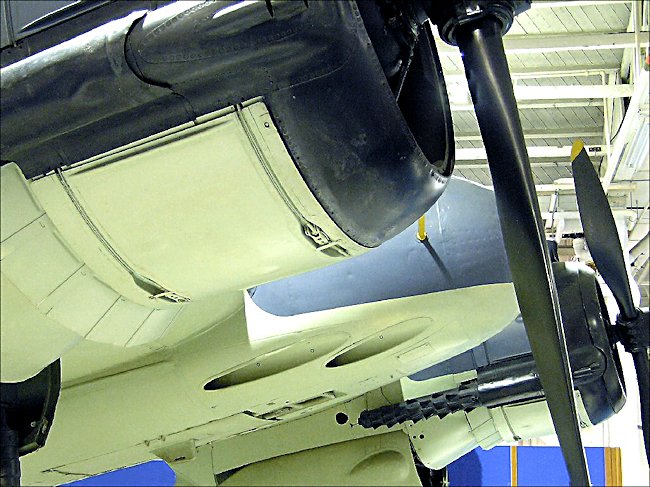Bristol Type 156 Beaufighter bomber
The Bristol Beaufighter strike fighter operated in North West Europe before it gained distinction in the Mediterranean and the Far East as a long range low level heavy fighter bomber. It had formidable fire power and was operated by the British and Australian Airforces. It was reported that the Japanese called the low level Bristol Beaufighter "Whispering Death" because attacking aircraft often were not heard or seen until too late.
RAF single-engined interceptors, such as the Hurricane and Spitfire lacked the endurance for effective standing patrols. The Bristol Beaufighter, entered service just on the outbreak of war at a time when it was most sorely needed. It had a range of 1,400 miles (2,253 km) with torpedo and normal fuel. With torpedo and long-range tanks fitted its range was 1,750 miles (2,816 km). A Spitfire's combat range was only 395 mph.

Photograph taken at the RAF Museum, Hendon, London NW9 5LL England
The Bristol Beaufighter first flew on 17th July 1939 and was delivered to RAF Fighter Command in April 1939 just before World War 2. It was designed by the Bristol Aeroplane Company. The Bristol Beaufighter was a modification on the Bristol Beaufort torpedo bomber. The Beaufort's bomb bay was removed, and four forward-firing 20 mm Hispano Mk III cannons were installed in the lower fuselage area. They were fed from drums containing 60 rounds of ammo but this needed the radar operator to change the ammunition drums by hand in flight. It was a difficult and unpopular task, especially on the night fighters where vision was poor. Because of complaints the drums were replaced by a belt-feed ammo system. Six .303 in (7.7 mm) Browning machine guns in mounted in the wings in addition to the hard hitting cannons. There were four starboard machine guns, two port.
The areas for the rear gunner and bomb-aimer in the Bristol Beaufort were removed in the Bristol Beaufighter. This left the pilot in a fighter-type cockpit and the navigator/radar operator sitting in the rear under a small Perspex bubble where the Beaufort's dorsal turret had been. Initially the Bristol Taurus engines used on the Beaufort were fitted to the Beaufighter. But they were not powerful enough for a fighter so they were replaced by the more powerful Bristol Hercules engine. It could fly at 320 mph (515 km/h) at 10,000 ft (3,050 m) 323 mph at 15,000 feet.
The Bristol Beaufighter was used as a home-defence night fighter during the Winter of 1940 - 1941. Very early operations were carried out without radar, relying on ground control, searchlights and luck to find their opponents which was a very difficult task. Even so, the Beaufighter achieved its first kill on 25 October 1940. A single short burst from its four cannons was often sufficient to shoot down an enemy bomber. It was the first RAF fighter to be equipped with airborne interception radar as it had enough performance to catch up with German raiders.

Photograph taken at the RAF Museum, Hendon, London NW9 5LL England
The first Bristol Beaufighter radar guided interception and victory was achieved on the night of 19/20 November 1940, by F.Lt John Cunningham of No. 604 Squadron. Cunningham would become the best known British night fighter pilot of the war, being given the nickname "Cat's Eyes" Cunningham after attempts to explain his prowess at a time when radar was a top secret. By the time the blitz ended, the Beaufighters were taking a heavy toll of German bombers, claiming 24 victories on the night of the 19/20 May alone. In 1943 the Mosquito had largely replaced the Beaufighter as a night-fighter, so the Beaufighters were sent to Coastal Command.
Costal Command added rockets and Torpedoes to the Bristol Beaufighter's armourment and used as a strike aircraft. The aircraft proved so effective in the Mediterranean against shipping, aircraft and ground targets that Coastal Command became the major user of the Beaufighter, replacing the now obsolete Bristol Beaufort and Blenheim. The Coastal Command Beaufighter was given the nickname "Torbeau" and was designated the Mk.XIC. Beaufighter TF Xs. The Torbeau was used to make precision attacks on enemy shipping at wave-top height with torpedoes or "60lb" RP-3 rockets. Coastal Command implemented new strike tactics which used a large formation of Beaufighters using cannon and rockets to suppress the anti aircraft guns followed by the Torbeaus at low level attacking with torpedoes. In March 1945 Bristol Beaufighter's sank five U-boats in two days.

Photograph taken at the RAF Museum, Hendon, London NW9 5LL England
The Beaufighter's ruggedness and reliability soon made the aircraft popular with crews. The last Bristol Beaufighter was delivered to the RAF in September 1945. A total of 5,562 Bristol Beaufighters were produced. The Australian Department of Aircraft Production constructed 365 mark 21 Bristol Beaufighter attack/torpedo variants for use by the Royal Australian Air Force RAAF. After World War Two they were used as target tugs. The last operational flight of a Bristol Beaufighter was in May 1960. The above photograph was taken in the Royal Air Force Museum in London, UK of the Beaufighter TF X, RD253, on display along with a Bristol Hercules engine. This aircraft flew with Portuguese Air Force as BF-13 in the late 1940s. It was used as an instructional airframe before its return to the UK in 1965. Restoration was completed in 1968, using components scavenged from a wide variety of sources.
Beaufighter books


Tweet